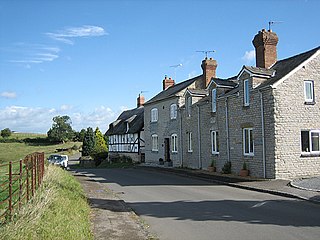Waltheof, Earl of Northumbria was the last of the Anglo-Saxon earls and the only English aristocrat to be executed during the reign of William I.

Hallamshire is the historical name for an area of South Yorkshire, England, approximating to the current City of Sheffield local government area.

Earl of Huntingdon is a title which has been created several times in the Peerage of England. The medieval title was associated with the ruling house of Scotland.

Burton Latimer is a town in North Northamptonshire, England, approximately 3.1 miles (5.0 km) from Kettering. At the 2011 census, its population was 7,449.
Maud, Countess of Huntingdon, or Matilda, was Queen of Scotland as the wife of King David I. She was the great-niece of William the Conqueror and the granddaughter of Earl Siward.

Charwelton is a village and civil parish about 5 miles (8 km) south of Daventry in Northamptonshire, England. The 2011 Census recorded the parish's population as 220.

Bedfordshire is an English ceremonial county which lies between approximately 25 miles and 55 miles north of central London.

Ralph de Gaël was the Earl of East Anglia and Lord of Gaël and Montfort. He was the leading figure in the Revolt of the Earls, the last serious revolt against William the Conqueror.

Temple Grafton is a village and civil parish in the Stratford-on-Avon district of Warwickshire, England, situated about 4 miles (6.4 km) east of Alcester and 14 miles (23 km) west of the county town of Warwick. The place name is misleading, the Knights Templar never having any association with the place but owing to a naming error made in the time of Henry VIII the mistake has been perpetuated. During the reign of Richard I the estate in fact belonged to the Knights Hospitaller. During the reign of Edward III in 1347 the village was recorded as Grafton Superior while neighbouring Ardens Grafton was named Inferior.

Elstow is a village and civil parish in the Borough of Bedford, Bedfordshire, England, about 2 miles (3.2 km) south of Bedford town centre.
Simon I de Senlis, 1st Earl of Northampton and 2nd Earl of Huntingdonjure uxoris was a Norman nobleman.

Denchworth is a village and civil parish about 2.5 miles (4 km) north of Wantage. It was part of Berkshire until the 1974 boundary changes transferred the Vale of White Horse to Oxfordshire. The 2011 Census recorded the parish's population as 171. The parish is bounded by the Land Brook in the west and the Childrey Brook in the east. The Great Western Main Line between Reading and Swindon runs through the parish just south of the village, but there is no station.

Elstow Abbey was a monastery for Benedictine nuns in Elstow, Bedfordshire, England. It was founded c.1075 by Judith, Countess of Huntingdon, a niece of William the Conqueror, and therefore is classed as a royal foundation.

Ardens Grafton is a hamlet or small village in the Stratford-on-Avon District of Warwickshire, England, situated about 4 miles (6.4 km) east of Alcester and 14 miles (23 km) west of the county town of Warwick. It has a main street and consists mostly of houses constructed of local stone with tiled roofs, with the exception of two properties, 'Manor Cottage' and 'Chapel House' both of which have timber-framed walls and a thatched roof. Two other buildings retain fragments of ancient framing. During the reign of Edward III in 1347 the village was recorded as Grafton Inferior while neighbouring Temple Grafton, 0.50 miles (0.80 km) to the East, was named Superior Other designations used during the Middle Ages were Nether Grafton, Grafton Inferior or Grafton Minor whilst the larger village of Temple Grafton was distinguished as Over Grafton, Grafton Superior, Church Grafton, or Grafton Major. A reference to 'Temple Grafton alias Ardens Grafton' occurs in 1650.
Castle Camps was a Norman Castle located in what is now the civil parish of Castle Camps, Cambridgeshire.

Sawtry Abbey was a Cistercian abbey located between Sawtry and Woodwalton in Cambridgeshire, England. The abbey was founded in 1147 by Simon II de Senlis, Earl of Northampton, who was the grandson of Earl Waltheof and Judith, the niece of William the Conqueror who held the manor when the Domesday Survey was compiled. It is the only Cistercian abbey in the county.
Truthwall is a hamlet southeast of Crowlas in the civil parish of Ludgvan, west Cornwall, England, United Kingdom.
Sir David Olifard was the first recorded Justiciar, governing the southern half of Scotland south of the rivers Forth and Clyde. Olifard was godson to King David I of Scotland, whose life he saved at the Rout of Winchester in 1141. Olifard is the first known chief of Clan Oliphant today.
Trenant Park is a Grade II listed country house in the civil parish of Duloe in east Cornwall, England, UK. It is surrounded by a large park and woodland. It is sited on a tongue of land between the East and West Looe rivers. The house was possibly built in the early 17th century, remodelled in the early 18th century, extended in the mid 19th century and divided into flats in the 20th century.
Sir John de Radynden (1274-c.1350) was the only child of Walter and Agatha. He inherited his father's estate of Radynden, as well as the properties of his mother and his aunt, Alice de Mucegros. He initially was in the service of Hugh Despenser the Elder and later was a Member of Parliament for Sussex.











